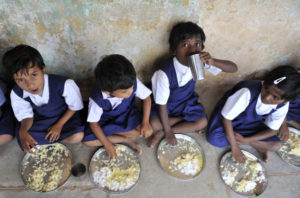Even when the central government is committed to a jobs guarantee, rationing of work opportunities can arise under decentralised implementation in poor places. This article examines India’s efforts to implement such a scheme and finds that there are two main drivers of this rationing: local administrative costs, and local corruption. Partial administrative reforms by the Centre can have perverse effects. Deeper policy reforms are needed to assure that stipulated rights for poor people are attained in practice.

Central governments often have ambitious and (in principle) commendable social policy goals, and these can also be electorally popular. But decentralised implementation is often required. Can the policies then be implemented in practice? How much does decentralised implementation constrain performance?
Centrally mandated job guarantees are an example. The idea of using work requirements on welfare (‘workfare’) to help implement a ‘right-to-work’ (RTW) policy has surfaced often in the history of social policy. For example, in the last few years of his life, Dr. Martin Luther King Jr. turned his attention from civil rights to poverty in America, where he saw high unemployment among poor families. King’s response was that “We need an Economic Bill of Rights. This would guarantee a job to all people who want work and are able to work” (quoted in Myers-Lipton 2015: xv). This was an instrumental case for RTW, in which ending poverty was seen as the overarching goal. The idea of a Federal Jobs Guarantee has resurfaced recently in the US (Paul et al. 2017).
Employment guarantee schemes in India
The idea has been especially influential in India, where the policy took the form of ‘employment guarantee schemes’. An influential early example is the Maharashtra Employment Guarantee Scheme (MEGS), started in 1973. The idea was scaled up to the national level in 2005 in the form of the Mahatma Gandhi National Rural Employment Guarantee Act (MNREGA), which is clearly the largest workfare scheme in the world. MNREGA promises 100 days of work per household per year, on demand, to all adults willing to supply unskilled manual labour to labour-intensive public works projects. The projects are mostly for water conservation/harvesting, drought protection, irrigation, roads, and sanitation. The work is to be paid at the statutory minimum wage rate notified for the programme, and workers are to be paid within 15 days of doing the work. If the work demanded cannot be provided, then an unemployment allowance is to be paid by the state government. MNREGA gives an important role to local (including village-level) officials in implementation.
Such rights-based ideas about distributive justice have had a long history. It is a superficially attractive idea to create new legal rights for things that matter to poor people to help reduce poverty. A RTW policy implemented through public employment can seem like a good option when poor people face risky environments and high unemployment rates, when the reliable information for targeting is limited, and if there is much useful work to do in poor areas. Realising that potential is another matter.
Will these rights be respected in practice? In a recent paper, I address that question in the context of India’s employment guarantee schemes (Ravallion 2019a). Based on a review of recent research, I argue that the self-targeting feature is plausible and consistent with the evidence. Participants tend to be poor, by any reasonable criteria. Yet it is far from obvious that this will be the best way to reduce poverty – taking freedom from poverty to be the overarching right – once one considers all the costs involved. These include implementation costs, pecuniary costs to the participants in the form of forgone earnings (which can exist even for underemployed workers), and the welfare loss from the work requirement relative to unconditional transfers (Murgai et al. 2016, Alik-Lagrange and Ravallion 2018). My study points to evidence suggesting that MNREGA is less cost-effective in reducing current poverty in poor areas through the earnings gains to workers than one would expect from even untargeted transfers, as in a universal basic income (UBI). That need not hold in other settings (Ravallion 2019b); for example, the cost-effectiveness comparison could switch in favour of workfare schemes if they can produce assets of value (directly or indirectly) to poor people. The point is that better targeting need not bring larger benefits to poor people.
The evidence is mixed on the performance of these schemes, which varies across states of India. It is especially worrying that the schemes appear to work less well in poorer states, where they are probably needed more. Survey evidence suggests that local rationing of the MNREGA work opportunities is common in poor areas (Dutta et al. 2012, Desai et al. 2015).
I try to understand how this happens, drawing on both theory and evidence. It is argue that local rationing of the work opportunities can readily arise from the existence of (often latent) local administrative costs in implementation and from the partial means used by the Centre to fight local corruption. The main concern with rationing is not that it undermines pro-poor targeting; indeed, that is not implied by the theoretical model of local corruption in Ravallion (2019a), and nor is it consistent with the evidence for India (for example, Dutta et al. 2014). However, rationing undermines the gains to poor people from the employment guarantee, including its insurance and empowerment benefits.
Ensuring the work guarantee benefits to those who need it the most
With decentralised implementation of the RTW, rationing can emerge in equilibrium given the local costs of employing workers and the scope for corruption. The RTW need not be feasible. Nonetheless, the share of demand that is rationed may well diminish as the scheme expands. The data for India are consistent with the prediction of the theoretical model that the rationing rate at the margin will be less than the average rate (Ravallion 2019a). By implication, the insurance and other benefits of the work guarantee will tend to emerge as the scheme expands above some point. Scaling up may well help.
The benefits to poor people can also be enhanced if local implementation costs are reduced. However, combining such cost savings with anti-corruption reforms that increase the expected marginal cost of corruption need not help. Raising the marginal cost of corruption is likely to reduce the extent to which employment is available to those who need it. When local administrative costs are reduced using a reform that also raises the expected marginal cost of corruption facing local officials – as exemplified by the efforts studied by Banerjee et al. (2016) to make record-keeping and reporting more transparent – there may be little or no net gain to workers in terms of attaining the RTW. Partial anti-corruption efforts and administrative reforms from the Centre can thus have ambiguous effects on the benefits to poor people from this type of policy (Ravallion 2019a).
Assuring that local agents do not have the power to ration work among those who need it may well require deeper local institutional reforms (Dutta et al. 2014). ‘Social audits’ – open village meetings fostering public disclosure of concerns – can help when backed up by credible public procedures for responding to grievances and protecting complainants. There is an obvious appeal to creating new legal rights for poor people, but successful implementation can be challenging for the same reasons that those people are poor in the first place.
Courtesy : Martin Ravallion (Georgetown University).

